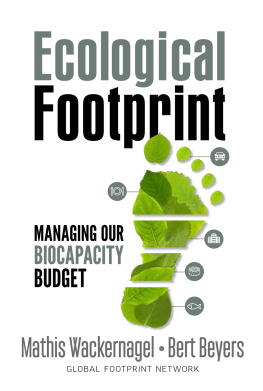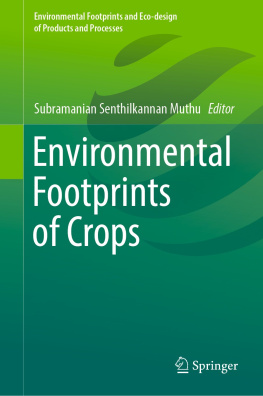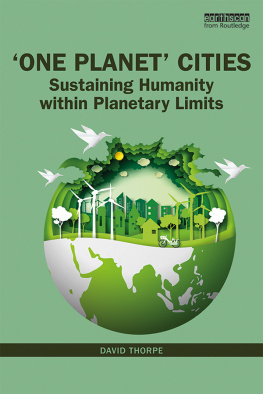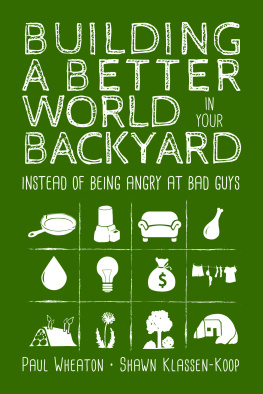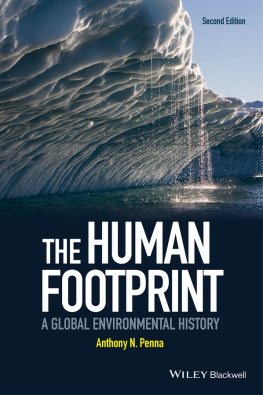CONTENTS
Guide
Jon R. Biemer is a mechanical engineer and holds a certificate in process-oriented psychology. For twenty-three years, he conducted research and managed programs for the Energy Efficiency group of Bonneville Power Administration. He now provides organizational development consulting to environmental nonprofits.
Jon and his wife, Willow, have adopted many of the lifestyle practices highlighted in Our Environmental Handprints. Their eco-remodeled home was featured on the Tour of Green Homes for Portland, Oregon. They turned their lawn into a food forest. They have lived without a car for thirteen years.
Jons forty-year career in sustainability includes facilitating the nations first industrial energy-efficiency conference, walking the proposed Keystone XL pipeline route from Alberta to Nebraska, and organizing local Pachamama Alliance programs.
E m Alter, Natalia Blackburn, Kenneth Stotler, and Karl Vischer have walked this path with me for a very long timethank you. Thank you as well to my agent, Lisa Hagan, and my book coach, Mark Malatesta, for their wise persistence.
The following people generously provided manuscript review: Christine Brautigam, Victoria Clevenger, Robin Cordova, Willow Dixon, Pamela Edwards, Doug Haines, Gayle Highpine, David Holladay, Sarah Horn, Diana Jones, Bob Leonard, Christine Lightcap, Milt Markewitz, Craig Moro, Linda Neale, Vera Sinnock, Karl Vischer, Lloyd Vivola, and Brian Wagner.
Also, thanks to Gregory Norris for giving me the opportunity to share my emerging Handprint ideas on the Handprinter website.
In this way, all of you own a part of the collective Handprint this book represents.
H ow do the Handprint opportunities in Our Environmental Handprints complement the solutions in Drawdown by Paul Hawken? Handprint opportunities address a broad range of environmental issues, while Drawdown solutions apply specifically to drivers of climate change. By sorting, sector by sector, we can see how the policy and engineering objectives of Drawdown solutions are supported by the individual actions suggested by Handprint opportunities. Put differently, both the solutions and opportunities below are all proactive responses to climate change. (The numbers refer to designations within each text.)
BUILDINGS AND CITIES
DrawdownSolutions. 27 District Heating. 31 Insulation. 33 LED Lighting (Household). 42 Heat Pumps. 44 LED Lighting (Commercial). 45 Building Automation. 54 Walkable Cities. 57 Smart Thermostats. 58 Landfill Methane. 59 Bike Infrastructure. 61 Smart Glass. 71 Water Distribution. 73 Green Roofs. 79 Net Zero Buildings. 80 Retrofitting.
Handprint Opportunities. 12.1 Install LED lights. 12.2 Choose Energy Star appliances. 12.3 Use clothes drying racks and hanging bamboo rods. 12.4 Use a food box. 12.5 Buy used house parts. 12.6 Post Whats green about this room? signs. 12.7 Eco-retrofit your home. 12.8 Move to a more earth-friendly home. 12.10 Live in a solar-friendly house. 12.11 Promote earth-friendly energy in your community. 19.2 Create climate neutral action plans.
ELECTRICITY GENERATION
DrawdownSolutions. 2 Wind Turbines (Onshore) Electricity Generation. 8 Solar Farms. 10 Rooftop Solar. 18 Geothermal. 20 Nuclear. 22 Wind Turbines (Offshore). 25 Concentrated Solar. 29 Wave and Tidal. 30 Methane Digesters (Large). 34 Biomass. 41 Solar Water. 48 In-Stream Hydro. 50 Cogeneration. 64 Methane Digesters (Small). 68 Waste-to-Energy. 76 Micro Wind. 77 Energy Storage (Distributed). 77 Energy Storage (Utilities). 77 Grid Flexibility. 78 Microgrids.
Handprint Opportunities. 5.4 Invest in Clean 200 companies. 5.5 Divest from Carbon Underground 200 companies. 14.1 Buy renewable power. 14.2 Support your state citizens utility board. 14.3 Work for a wind, solar, or efficiency company. 14.4 Promote energy efficiency. 14.5 Donate to market transformation organizations. 14.6 Share the land you love with windmills. 14.7 Buy and use a solar cooker. 14.8 Install solar collectors. 14.9 Go community solar. 14.10 Use solar-powered devices. 19.1 Advocate for 100 percent renewable energy. 19.2 Create climate neutral action plans. 19.3 Put a price on carbon. 19.6 Ensure that the United States fully recommits to the Paris Agreement. 19.8 Find employment in sustainable development or climate change mitigation.
FOOD
DrawdownSolutions. 3 Reduced Waste. 4 Plant-Rich Diet. 9 Silvopasture. 11 Regenerative Agriculture. 14 Tropical Staple Trees. 16 Conservation Agriculture. 17 Tree Intercropping. 19 Managed Grazing. 21 Clean Cookstoves. 23 Farmland Restoration. 24 Improved Rice Cultivation. 28 Multistrata Agroforestry. 53 System of Rice Intensification. 60 Composting. 65 Nutrient Management. 67 Farmland Irrigation. 72 Biochar.
Handprint Opportunities. 4.4 Share your garden and orchard surplus. 10.1 Support The Land Institute. 10.2 Buy agricultural carbon offsets. 10.3 Spread compost on bare or compacted land. 10.4 Study botany and indigenous food cultivation. 10.5 Use sustainable farming practices. 10.6 Become certified as an organic grower. 10.7 Practice mob grazing. 11.1 Grow food in a garden. 11.2 Buy food at farmers markets. 11.3 Become a community-supported agriculture member. 11.4 Go gleaning. 11.6 Buy Demeter Certified Biodynamic products. 11.7 Serve vegetables, fruit, and nuts. 11.8 Serve organic food. 11.9 Serve perennial food. 11.10 Serve raw food and fermented food. 11.11 Explore plant-based alternatives to animal products. 11.12 Create earth-friendly recipes. 11.13 Let go of beef. 11.14 Teach others to serve earth-friendly food. 11.15 Write online reviews.
LAND USE
DrawdownSolutions. 5 Tropical Forests. 12 Temperate Forests. 13 Peat-lands. 15 Afforestation. 35 Bamboo. 38 Forest Protection. 39 Indigenous Peoples Land Management. 51 Perennial Biomass. 52 Coastal Wetlands.
Handprint Opportunities. 1.1 Introduce children to trees. 1.6 Plant trees. 1.7 Donate to plant trees. 1.8 Volunteer for your local arboretum or botanical garden. 1.9 Endow the Tree Fund. 1.10 Research how trees sequester carbon. 1.12 Offset your carbon footprint. 1.13 Develop a carbon offset policy at work. 2.1 Buy plant-based soap. 2.2 Buy earth-friendly toilet paper. 2.3 Give cloth napkins and shopping bags as gifts. 2.4 Carry and use reusable spoon, fork, or spork and bowl. 2.5 Buy bamboo, machine-washable merino wool, ramie, organic hemp, or organic cotton clothing. 2.6 Buy classy used clothing. 15.1 Visit a national park. 15.2 Support trail building and maintenance. 15.3 Support indigenous people who protect the land. 15.4 Donate to African Parks. 15.5 Bequest your land to a conservation organization. 15.6 Form a land trust. 15.7 Support organizations that protect endangered species. 15.8 Create a certified wildlife habitat. 15.9 Use permaculture principles. 15.10 Use mycelium (mushrooms) to treat biohazards. 15.11 Help expand the fungi knowledge base. 15.12 Promote brownfield recovery. 15.13 Adopt a park.
MATERIALS
DrawdownSolutions. 1 Refrigerant Management. 36 Alternative Cement. 46 Water SavingHome. 47 Bioplastic. 55 Household Recycling. 56 Industrial Recycling. 70 Recycled Paper.
Handprint Opportunities. 1.2 Buy 100 percent recycled printer paper. 1.3 Move to online bill paying. 1.4 Switch to double-sided (duplex) printing. 1.5 Switch to reading e-books. 2.2 Buy treeless toilet paper. 4.3 Donate reusables to a reselling outlet. 4.5 Use Freecycle or Craigslist. 12.8 Salvage tear-down buildings. 17.4 Propose to ban plastic bags. 18.1 Buy and sell clothes and furniture from a resale store. 18.2 Rent instead of buying tools and cars. 18.3 Buy goods made from recycled materials. 18.4 Recycle paper, metal, glass, and acceptable plastics through recycling programs. 18.5 Use TerraCycle Zero Waste Boxes. 18.7 Buy products with Cradle to Cradle Certified materials.



